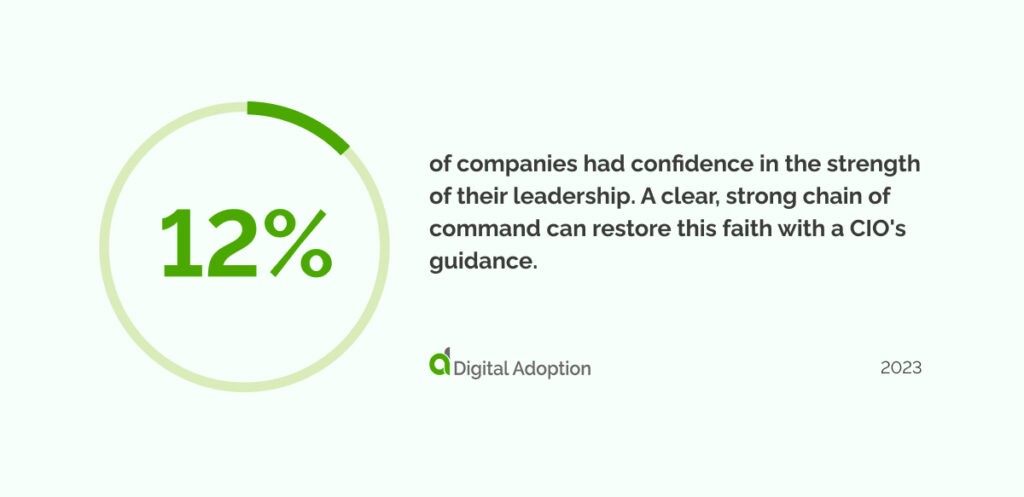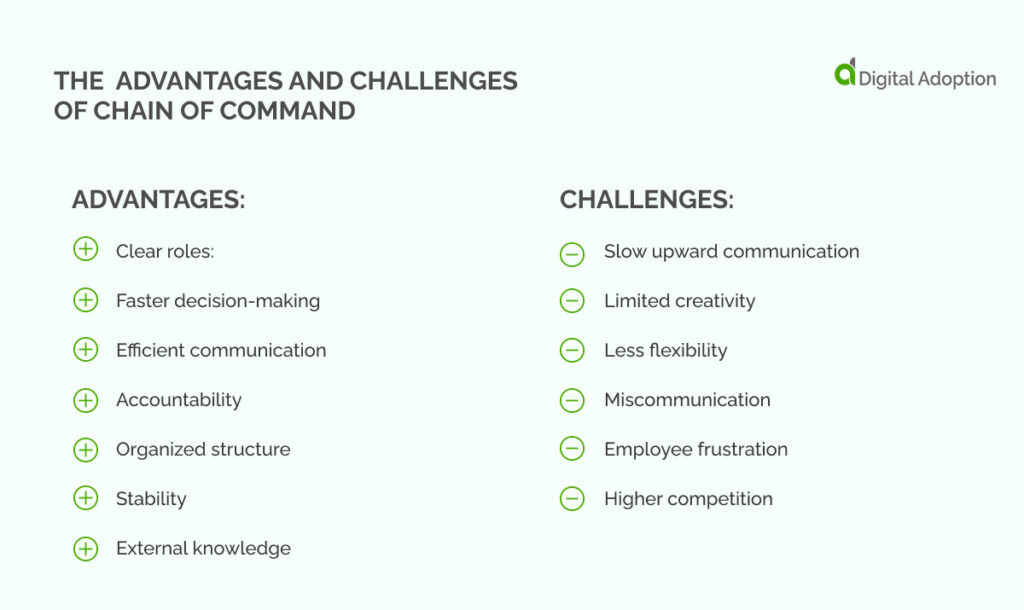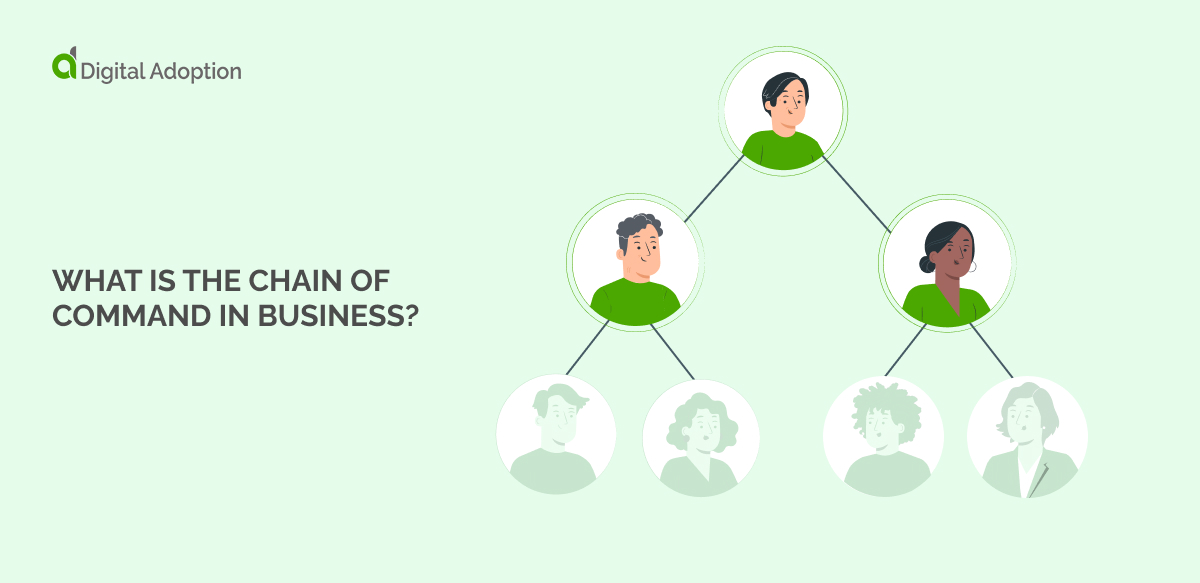The chain of command is important, but only some leaders fully understand it.
The chain of command allows a smooth flow of information from C-suites to managers and employees. It promotes task accountability and responsibility.
In 2023, only 12% of companies had confidence in the strength of their leadership. A clear, strong chain of command can restore this faith with a CIO’s guidance.

This article defines the chain of command in business, its importance, levels, advantages and disadvantages, and examples. When you’ve finished, you’ll know what a chain of command is and why it’s important for organizational structure and responsibility.
What is chain of command in business?
The chain of command in business is a system that guides how people work and grow together for better organizational development and scalability. It’s like a ladder where each person knows where to stand. They know who they report to above them on the ladder. They also know who gives them instructions.
This system starts with the top boss and goes down to all the workers. It helps everyone clearly understand their roles and responsibilities.
For example, if a store worker has a problem, they tell their manager. If the issue is challenging, the manager might then talk to the store’s owner. The owner decides what to do, and the manager tells the worker how to fix it.
Businesses can run smoothly by knowing who makes decisions and who to ask for help. They can solve problems quickly. This structure makes everything more efficient.
The importance of chain of command
The chain of command creates a clear structure. Everyone knows who to report to and to whom each employee gives instructions.
This structure is essential, especially in a digital transformation, because everyone needs to work together to make large-scale changes as part of any digital business strategy.
It helps people understand their roles and responsibilities, stopping confusion about what to do. It also speeds up decision-making and makes decisions more efficient. The right people at the right levels make all the right decisions.
This way, everyone knows who to ask for help or who to inform about important things. When problems arise, they can be quickly passed up the chain of command and arrive at the right person with the authority to solve them.
Without a chain of command, a large company would face confusion. Employees wouldn’t know who to report to or who makes decisions. This situation would lead to poor communication, unclear roles, delayed decisions, and chaos, making it a huge challenge for the company to function effectively.
The chain of command structure keeps the business running smoothly. It ensures that everyone works together effectively to achieve the company’s goals.
The different levels of the chain of command in business
The different levels of the chain of command are important. They form the system’s structure and clarify who answers and reports to whom. It clearly defines roles and can make communication and responsibility clearer. The owner is at the top, management is in the middle, and employees are at the bottom.
Owner
The owner is at the top of the chain of command and is responsible for making the biggest decisions in the business.
The owner sets the goals and direction of the company, deciding what the business will focus on and how it will grow. They oversee the entire operation and have the final say on important matters. The owner might hire the management team to help them run the business.
In small businesses, the owner may be very involved in daily operations, while larger companies focus more on long-term planning and strategy.
Management team
The management team is the middle level in the chain of command. It consists of people who help the owner run the business by managing different parts of the company.
Managers are responsible for specific areas like sales, marketing, or human resources. They set the owner’s goals and ensure the employees achieve them.
Managers give instructions, solve problems, and make decisions within their departments. They also communicate between the owner and the employees, ensuring everyone understands what they need to do and how to do it.
The management team is crucial in keeping the business organized and running smoothly.
Employees
Employees are at the bottom of the chain of command but are just as important as the other levels.
Employees are the people who carry out the day-to-day tasks that keep the business running. They follow their managers’ instructions and do the work, which may include serving customers, making products, or handling paperwork.
Employees report to their managers, who guide them and help solve problems.
By doing their jobs well, employees help the business achieve its goals and ensure everything runs smoothly.
Although it’s a simple system and easy to learn, many companies do not follow the chain of command. Being aware of and implementing this system can help you support your staff to be more productive and gain an edge over your competitors.
Examples of chain of command in business
The best way to learn is by seeing examples of how a system works in different industries. The examples of chain of command below show how it works in a marketing agency, tech company, and a manufacturing plant. Take a look and then compare these examples to your own business and see how a chain of command may or may not work for you.
Marketing agency
The agency owner or director sits at the top of most marketing agencies. They control the direction of broad goals and all strategies.
The next level is managers. They are responsible for different teams, which often include social media, content creation, and advertising. Managers guide their teams to ensure high productivity, which helps them achieve goals.
Employees like designers, writers, and analysts follow the manager’s guidance. They use this guidance to build campaigns and content. This structure ensures organized agency work and that projects meet client expectations.
Tech company
The chain of command in tech companies is similar to that of marketing agencies but with a few differences.
It begins with the CEO or founder, who sets the company’s direction and goals. Below the founder are managers for various departments, including engineering, product development, and customer support.
Managers oversee teams to ensure that product development is on schedule. This process involves ensuring employees fix bugs to give customers a seamless, satisfying experience.
Employees, like software developers, designers, and support agents, report to their managers. They work on coding, designing, and helping users and receive guidance from managers to help them focus and resolve issues.
This system ensures that the tech company runs efficiently. Each team focuses on their specific tasks to create new technology.
Manufacturing plant
The chain of command in a manufacturing plant begins with the plant manager. They are key players because they are responsible for the entire operation. They decide on production goals and ensure everything runs smoothly.
Below the plant manager are supervisors. They manage different sections of the plant. Examples of these sections include assembly, quality control, and shipping.
These supervisors are more important than the two examples above. Manufacturing has many safety risks and requirements. Supervisors must be aware of changing compliance regulations to guide their workers and ensure that products are made correctly, safely, and on time.
Employees work on the factory floor. Manufacturing employees include machine operators and assemblers. They follow the supervisors’ instructions to complete their tasks.
This structure helps ensure that the plant produces high-quality products efficiently and safely.
Consider these examples and how they compare to your company. If your company is similar to any of the above examples, it may be time to implement a chain of command and enjoy its benefits.

Advantages and disadvantages of chain of command
Like any organizational structure, the chain of command system has advantages and disadvantages in equal measure.
Awareness of all these pluses and minuses can help you optimize your use of this system. Plan to reduce the downsides so you can focus on enjoying the positive aspects.
Advantages of chain of command
Most companies use the chain of command due to its many advantages.
The advantages of chain of command include:
- Clear roles: Everyone knows their job and who to report to, which reduces confusion.
- Faster decision-making: Decisions are quick because it’s clear who has the authority.
- Efficient communication: Information flows smoothly from the top to the bottom, ensuring everyone is on the same page.
- Accountability: It’s easy to identify who is responsible for what, making problem-solving quicker.
- Organized structure: The chain of command helps keep the business well-organized, making it easier to manage and achieve goals.
- Stability: Defined roles promote stability in the workplace and employee wellbeing. All employees know what to do and ask for support if problems occur.
- External knowledge: Customers are often aware of the value of titles. Established roles, like senior manager, are helpful when a customer is unhappy and feels valued when speaking to high-status staff.
Being aware of these advantages can help you ensure you get the most out of this organizational structure.
Disadvantages of chain of command
All types of organizational structures have their disadvantages. The chain of command has disadvantages, too.
The disadvantages of chain of command include:
- Slow upward communication: Information from lower levels can take time to reach the top, which might delay important decisions.
- Limited creativity: Employees may feel restricted and not share new ideas because they always have to get approval from above.
- Less flexibility: The strict structure can make it hard to adapt quickly to changes in the business environment.
- Miscommunication: Misunderstandings can happen if information doesn’t move smoothly through the chain.
- Employee frustration: Some workers might feel that managers don’t listen to their concerns or that they have little control over their work, leading to frustration.
- Higher competition: Disagreement caused by competing needs at higher levels can lead to distrust from lower levels.
Being aware of these disadvantages in advance of putting the chain of command into action helps you plan. You can plan how to reduce the negative impact of each disadvantage in advance and optimize how you use it.
Promote a structured, stable workplace with chain of command
It’s important to focus on your employees at the lower levels of the chain to ensure the system works correctly. The best way to achieve this is to use the chain of command to build a structured, stable workplace.
First, communicate roles and responsibilities. Use a chart that shows every role’s position in the chain of command, including responsibilities and reporting relationships. This process makes the workplace feel stable because everyone knows their role and communication procedures.
Second, communication channels should be used that work and do not change. Use effective channels for receiving feedback, meetings, and updates. Keeping everyone informed in a structured way keeps them satisfied.
Lastly, ensure you provide the best training and that the chain of command is part of onboarding training. Offer leaders the necessary leadership training and give employees communication training to support everyone’s respect for the hierarchy.
Using a chain of command to promote a structured and stable workplace encourages staff at every level to follow it. The rewards are efficient communication, higher productivity, and increased revenue.
FAQS
What is a vertical chain of command?
A vertical chain of command is a way to show who is in charge at different levels in a company. It starts with the boss at the top and goes down to the workers. Each level reports to the one above it. It allows everyone to know who to ask for help.
What is a flat chain of command?
A flat chain of command means there are few levels of bosses between the top and the workers. This approach makes it easier for everyone to talk to each other directly, with fewer steps to go through. It can help people share ideas and solve problems faster.
How do you explain the chain of command to staff?
Explain the chain of command to staff by showing them a chart with everyone’s roles and who they report to. Tell them that each person has a boss. Mention that they should ask their boss for help or to solve problems. This approach helps keep things organized and running smoothly.




![4 Best AI Chatbots for eCommerce [2025]](https://www.digital-adoption.com/wp-content/uploads/2025/03/4-Best-AI-Chatbots-for-eCommerce-2025-img-300x146.jpg)


![13 Digital Transformation Enablers [2025]](https://www.digital-adoption.com/wp-content/uploads/2025/02/13-Digital-Transformation-Enablers-2025-img-300x146.jpg)



![4 Best AI Chatbots for eCommerce [2025]](https://www.digital-adoption.com/wp-content/uploads/2025/03/4-Best-AI-Chatbots-for-eCommerce-2025-img.jpg)

